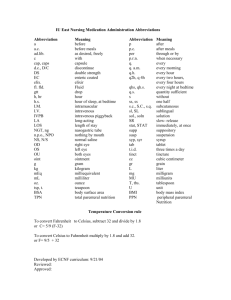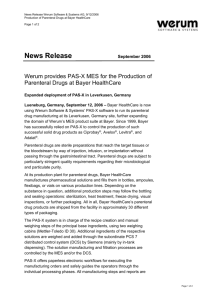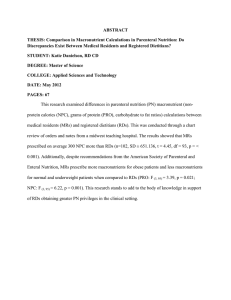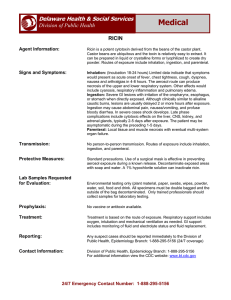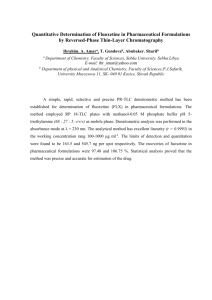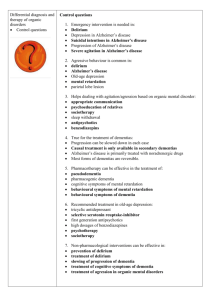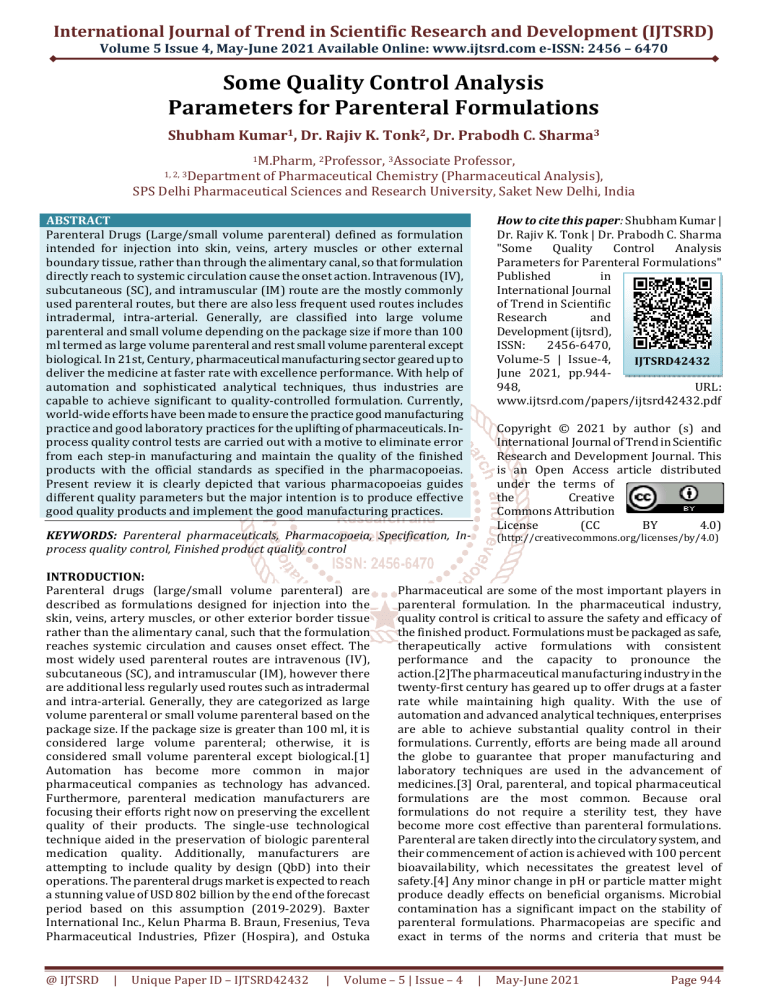
International Journal of Trend in Scientific Research and Development (IJTSRD) Volume 5 Issue 4, May-June 2021 Available Online: www.ijtsrd.com e-ISSN: 2456 – 6470 Some Quality Control Analysis Parameters for Parenteral Formulations Shubham Kumar1, Dr. Rajiv K. Tonk2, Dr. Prabodh C. Sharma3 1M.Pharm, 2Professor, 3Associate Professor, of Pharmaceutical Chemistry (Pharmaceutical Analysis), SPS Delhi Pharmaceutical Sciences and Research University, Saket New Delhi, India 1, 2, 3Department ABSTRACT Parenteral Drugs (Large/small volume parenteral) defined as formulation intended for injection into skin, veins, artery muscles or other external boundary tissue, rather than through the alimentary canal, so that formulation directly reach to systemic circulation cause the onset action. Intravenous (IV), subcutaneous (SC), and intramuscular (IM) route are the mostly commonly used parenteral routes, but there are also less frequent used routes includes intradermal, intra-arterial. Generally, are classified into large volume parenteral and small volume depending on the package size if more than 100 ml termed as large volume parenteral and rest small volume parenteral except biological. In 21st, Century, pharmaceutical manufacturing sector geared up to deliver the medicine at faster rate with excellence performance. With help of automation and sophisticated analytical techniques, thus industries are capable to achieve significant to quality-controlled formulation. Currently, world-wide efforts have been made to ensure the practice good manufacturing practice and good laboratory practices for the uplifting of pharmaceuticals. Inprocess quality control tests are carried out with a motive to eliminate error from each step-in manufacturing and maintain the quality of the finished products with the official standards as specified in the pharmacopoeias. Present review it is clearly depicted that various pharmacopoeias guides different quality parameters but the major intention is to produce effective good quality products and implement the good manufacturing practices. How to cite this paper: Shubham Kumar | Dr. Rajiv K. Tonk | Dr. Prabodh C. Sharma "Some Quality Control Analysis Parameters for Parenteral Formulations" Published in International Journal of Trend in Scientific Research and Development (ijtsrd), ISSN: 2456-6470, Volume-5 | Issue-4, IJTSRD42432 June 2021, pp.944948, URL: www.ijtsrd.com/papers/ijtsrd42432.pdf KEYWORDS: Parenteral pharmaceuticals, Pharmacopoeia, Specification, Inprocess quality control, Finished product quality control (http://creativecommons.org/licenses/by/4.0) INTRODUCTION: Parenteral drugs (large/small volume parenteral) are described as formulations designed for injection into the skin, veins, artery muscles, or other exterior border tissue rather than the alimentary canal, such that the formulation reaches systemic circulation and causes onset effect. The most widely used parenteral routes are intravenous (IV), subcutaneous (SC), and intramuscular (IM), however there are additional less regularly used routes such as intradermal and intra-arterial. Generally, they are categorized as large volume parenteral or small volume parenteral based on the package size. If the package size is greater than 100 ml, it is considered large volume parenteral; otherwise, it is considered small volume parenteral except biological.[1] Automation has become more common in major pharmaceutical companies as technology has advanced. Furthermore, parenteral medication manufacturers are focusing their efforts right now on preserving the excellent quality of their products. The single-use technological technique aided in the preservation of biologic parenteral medication quality. Additionally, manufacturers are attempting to include quality by design (QbD) into their operations. The parenteral drugs market is expected to reach a stunning value of USD 802 billion by the end of the forecast period based on this assumption (2019-2029). Baxter International Inc., Kelun Pharma B. Braun, Fresenius, Teva Pharmaceutical Industries, Pfizer (Hospira), and Ostuka @ IJTSRD | Unique Paper ID – IJTSRD42432 | Copyright © 2021 by author (s) and International Journal of Trend in Scientific Research and Development Journal. This is an Open Access article distributed under the terms of the Creative Commons Attribution License (CC BY 4.0) Pharmaceutical are some of the most important players in parenteral formulation. In the pharmaceutical industry, quality control is critical to assure the safety and efficacy of the finished product. Formulations must be packaged as safe, therapeutically active formulations with consistent performance and the capacity to pronounce the action.[2]The pharmaceutical manufacturing industry in the twenty-first century has geared up to offer drugs at a faster rate while maintaining high quality. With the use of automation and advanced analytical techniques, enterprises are able to achieve substantial quality control in their formulations. Currently, efforts are being made all around the globe to guarantee that proper manufacturing and laboratory techniques are used in the advancement of medicines.[3] Oral, parenteral, and topical pharmaceutical formulations are the most common. Because oral formulations do not require a sterility test, they have become more cost effective than parenteral formulations. Parenteral are taken directly into the circulatory system, and their commencement of action is achieved with 100 percent bioavailability, which necessitates the greatest level of safety.[4] Any minor change in pH or particle matter might produce deadly effects on beneficial organisms. Microbial contamination has a significant impact on the stability of parenteral formulations. Pharmacopeias are specific and exact in terms of the norms and criteria that must be Volume – 5 | Issue – 4 | May-June 2021 Page 944 International Journal of Trend in Scientific Research and Development (IJTSRD) @ www.ijtsrd.com eISSN: 2456-6470 followed when generating monographs for such formulations, and they serve as a guide for the industries. According to the International Council for Harmonization, pharmacopoeias provide useful instructions for overcoming these flaws by following current good manufacturing practices and harmonizing standard operating procedures (ICH).[5] QUALITY CONTROL PARAMETERS In-process quality control tests are performed with the goal of eliminating errors from each step of the production process and ensuring that the completed goods meet the approved pharmacopoeia requirements. [6]In-process control tests are important for parenteral quality since they assist to embed excellence into the products. The final product quality controls tests assess the qualitative and quantitative aspects of pharmaceutical items. As a result, the goal of this research is to give succinct information on the numerous quality control parameters for parenteral formulations as defined by various pharmacopoeias.[7] General and Universal Tests for Parenteral Formulations: Description: Specification and qualitative description of the parenteral formulations are significant for physical inspection. Forexample, the description of parenteral formulations on a specification may read: transparent formulation, category and labeling including ingredients and excipients, imprinted with ‘‘Rx” in some countries as per their rules and regulations.[8] Identification: Identification or identity test is to characterize the identity of the active pharmaceutical ingredient (API) in the formulations. This test is capable to differentiate between ingredients of closely related structures that are likely to be present. [9] Assay: This test determines the strength (purity of active ingredients/content of the API) in the parenteral formulations. [10] Impurities: This test is aimed quantify the presence of any kind of impurities that is not the API or an excipient of parenteral formulations. The most common type of impurities that are measured is related substances, which are processed impurities from the new drug substance synthesis, degradation products of the API, or both. [11] Quality control parameters of parenteral pharmaceuticals: Test for Uniformity of Content: As per BP, unless otherwise prescribed or justified and authorized, single-dose suspensions for injection with a content of API less than 2 mg or less than 2 % of the total mass, or with a unit mass equal to or less than 40 mg comply with uniformity of content of single-dose formulations. If the formulation contains more than one active substance, the requirement applies only to those substances that correspond to the monographs. [12] As per IP, unless otherwise stated in the individual monograph, suspensions for injection that are presented in single dose containers and that contain less than 10 microgram or less than 10 percent of active ingredient comply with the monographs for specific test. Suspensions for injection containing more than one active ingredient carried out the test for each active ingredient that corresponds to the specified conditions.[13] In line with IP, unless otherwise stated in the individual monograph, powders for injection that contain 10 mg or less than 10 mg or less than 10 percent of active ingredient or that have a unit weight equal to or less than 50 mg comply with the test for uniformity of content described under Injections. [14] Another category contains powders for injection that contain more than one active ingredient. Carry out the test for each active ingredient that corresponds to the pharmacopoeia, with the exception of multivitamins and trace elements powders for injection. Only when the content of active ingredient(s) in a pooled sample of the formulation has been demonstrated to be within acceptable limits of the claimed content should the test for uniformity of content be performed.[15] Determine the individual amounts of active substance(s) of 10 dosage units taken at random, according per British and Indian pharmacopoeias, using an appropriate analytical technique in this analysis. If each individual content is between 85 - 115 percent of the average content, the parenteral formulation passes the test. If more than one individual content is beyond these limitations, or if one individual content is beyond the limits of 75 percent to 125 percent of the average content, the formulation fails the test [30,31].Determine the individual contents of additional 20 dosage units chosen at random if one individual content is beyond the ranges of 85 percent to 115 percent but within the ranges of 75 percent to 125 percent. If no more than one of the individual contents of the 30 units is outside the range of 85 percent to 115 percent of the average content, and none is outside the range of 75 percent to 125 percent of the average content, the formulation passes the test. [16] Test for Uniformity of Mass: For this test as per BP, remove any paper labels from a container and wash and dry the outside. Open the container and without delay weigh the container and its contents. Empty the container as thoroughly as possible by gently tapping, clean it if required with purified water and then with ethanol (96%), and dry at 100-105 °C for 1 hour, or dry at a lower temperature to constant mass if the nature of the container prevents heating at this temperature. Allow to cool completely in a desiccator before weighing. The difference between the weighing is the mass of the contents. Carry on with the procedure for the remaining 19 containers.[17] Calculate the average weight. If no more than two of the individual weights deviates from the average weight by more than 10%, and none deviates by more than 20%, the results are consistent with IP. According to BP, in order to pass this test, no more than two individual masses of parenteral formulations must differ from the average mass by more than the percentage deviation stated in Table 1, and none must differ by more than twice that percentage. Table: Indicating the limits for uniformity of mass as per the British Pharmacopeia Dosage Form Average Mass Percentage Deviation Powder for parenteral More than 40 mg administration (single dose) @ IJTSRD | Unique Paper ID – IJTSRD42432 | Volume – 5 | Issue – 4 10 | May-June 2021 Page 945 International Journal of Trend in Scientific Research and Development (IJTSRD) @ www.ijtsrd.com eISSN: 2456-6470 Test for Extractable Volume of Parenteral Formulations: For Extractable Volume analysis, suspensions and emulsions are shaken before application of formulation and before the determination of the density. Oily and viscous formulations may subject to temperature dependent change according to the instructions on the label, if necessary, and thoroughly shaken immediately before removing the contents. The contents are then brought to (20-25) °C before measuring the volume. [18] Single-Dose Containers: According to the British Pharmacopeia, select 1 container if the nominal volume is 10 mL or more, 3 containers if the notional volume is greater than 3 mL but less than 10 mL, or 5 containers if the notional volume is 3 mL or less. Fill a dry syringe with the complete contents of each container selected, not to exceed 3 times the volume to be measured, and equipped with a 21-gauge needle not less than 2.5 cm in length. Remove any air bubbles from the syringe and needle, then empty the contents of the syringe without emptying the needle into a standardised dry cylinder (graded to contain rather than deliver the indicated quantities) of sufficient size to contain at least 40% of the graduated volume. Alternatively, the volume of the contents in millilitres may be estimated by dividing the mass in grams by the density in millilitres. [19]For containers with a nominal volume of 2mL or less, the contents of a sufficient number of containers can be pooled to achieve the volume necessary for the measurement, as long as each container has its own dry syringe assembly. Open containers with a capacity of 10mL or more and empty the contents immediately into the graduated cylinder or tared beaker to ascertain the contents. In the event of containers inspected individually, the volume is not less than the nominal volume; in the case of containers with a nominal capacity of 2 mL or less, the volume is not less than the total of the nominal volumes of the containers considered collectively.[20] Multi-Dose Containers: As per BP and JP, for injections in multi dose containers labelled to deliver a certain number of doses of a specified volume. Select one container and follow the single-dose container instructions, using the same number of separate syringe assemblies as the number of doses given. Each syringe provides not less than the specified dose due to the large capacity. [21] Microscopic Particle Count Test: Single units are tested for large-volume parenterals. The contents of 10 or more units are combined in a cleaned container for small-volume parenterals less than 25 mL in volume; where justified and authorised, the test solution may be prepared by mixing the contents of a suitable number of vials and diluting to 25 mL with particle-free purified water or with an appropriate solvent without contamination of particles when particle free purified water is not suitable. Individual testing is possible for small-volume parenterals with a volume of 25 mL or more. [22]Powders for parenteral administration are constituted with particle-free purified water or with an appropriate solvent without contamination of particles when particle-free purified water is not suitable. To offer a statistically reliable assessment, the number of test specimens must be sufficient. Based on an acceptable sample plan, fewer than 10 units of large volume parenterals or small-volume parenterals with a volume of 25 mL or more may be evaluated. [23] Using several millilitres of particlefree filtered water, wet the interior of the filter holder fitted @ IJTSRD | Unique Paper ID – IJTSRD42432 | with the membrane filter. Apply vacuum to the whole volume of a solution pool or a single unit as it is transferred to the filter funnel. If necessary, add a part of the solution at a time until the entire volume is filtered. Begin cleaning the inner walls of the filter holder with a jet of particle-free filtered water after the last addition of solution has been made. Maintain the vacuum until liquid is no longer visible on the membrane filter's surface. Place the filter in a Petri dish and keep the cover slightly ajar to enable the filter to air dry. Place the Petri dish on the microscope stage after the filter has dried, scan the entire membrane filter under the reflected light from the illuminating device, and count the number of particles that are equal to or greater than 10 µm and the number of particles that are equal to or greater than 25 µm. It is also possible to do a partial filter count and calculate the overall filter count. Calculate the average number of particles in the formulation under consideration. When performing the microscopic particle count test, do not try to size or enumerate amorphous, semi-liquid, or otherwise morphologically unclear materials on the membrane filter that have the appearance of a stain or discoloration. Surface relief is little or absent, and the materials have a gelatinous or film-like appearance. In such instances, a sample of the solution can be tested using the light obscuration particle count test to help in the interpretation of the enumeration. [24] Sterility Test One of the most essential quality control parameters is sterility, which aims to completely eliminate any microorganism from the formulation in order to achieve safety. According to the BP and USP, the sterility analysis can be performed via membrane filtration or direct inoculation of the culture media with the product to be tested.[21]For the comparison study, appropriate negative controls are chosen. Fluid thioglycollate is mostly used for the culture of anaerobic bacteria, although it may also be used to identify aerobic microorganisms. For the culture of both fungal and aerobic bacteria, soya-bean casein digest medium is recommended. The most significant and absolutely necessary property of parenteral products is sterility. The absence of all living microorganisms is referred to as sterility. It is an absolute term. Sterility tests are performed using the following methods: A. Direct transfer method /technique. B. membrane filtration method /technique. A) Direct Transfer method: -It's a traditional sterility test that involves directly inoculating the required volume of a sample into two test tubes using FTM, SCDM culture medium. When the requirement for repetition in opening container, sampling, transferring, and mixing rises, this approach is easy in principle but challenging in practice, resulting in operator fatigue and detoriation in technique.[21] B) Membrane Filtration method: -It was made official in 1970 by the U.S.P. It is a more extensively utilized and popular approach than direct transfer method. Successful employment needs a higher level of skill and knowledge than the approach of direct transfer method. This method involves filtration of the sample via hydrophobic membrane filters with a porosity of 0.22 micron and a diameter of 47mm. After filtration, the membrane is divided into two halves and one half is inserted in two test tubes contain FTM, SCDM media. If there is no apparent indication of microbial Volume – 5 | Issue – 4 | May-June 2021 Page 946 International Journal of Trend in Scientific Research and Development (IJTSRD) @ www.ijtsrd.com eISSN: 2456-6470 growth in the culture medium in the test tube, the sample representing the lot is free of intrinsic contamination. If visible microbial growth is detected or the test is deemed invalid due to inadequate environmental conditions, the sterility test must be repeated. This interpretation must be made by personnel who are familiar with aseptic processing, industrial sterilisation methods, and environmental control procedures used in the test facility.[22] Pyrogen Test Pyrogens are metabolic products produced by microorganisms, with Gm-ve bacteria producing the most powerful pyrogens. These lipo polysaccharides are chemically and thermally stable, and they can pass through bacteria retentive filters. When these pyrogens are injected into the body, they cause a rapid onset of fever, body aches, and vasoconstriction within 1 hour. The following tests are used to determine the presence of pyrogens in sterile parenteral products. These are: - guides different quality parameters but the major intention is to produce effective good quality products and implement the good manufacturing practices. ACKNOWLEDGMENT I am very thankful to Dr. Rajiv Kumar Tonk and Dr. Prabodh Chander Sharma, SPS, Department of pharmaceutics Chemistry, Delhi Pharmaceutical Science and Research University, Saket, New Delhi for providing the guidance and support for publishing this article. REFERENCES [1] Remington, the Science and Practice of Pharmacy, Parenteral Preparation, 20th edition. Philadelphia: ISE publication 1 (2000). [2] Ford JL. “Parenteral products”. In: Aulton ME, (ed.) Pharmaceutics: The Science of Dosage Form Design. New York; Longman (1988). [3] Ansel HC., et al. “Pharmaceutical dosage forms and drug delivery system, 7th edition”. Lippincott Williams and Wilkins: Philadelphia (1999) [4] Colombo G., et al. “Stabilized aqueous suspensions for parenteral use”. US6495534 (2002). [5] Beecher P. “Encyclopedia of emulsion technology, basic theory”. Marcel Dekker: New York 1 (1983) [6] Collins Gold LC., et al. “Parenteral emulsions for drug delivery”. Advanced Drug Delivery Reviews 5 (1990): 189-208 [7] Singh M and Ravin L. “Parenteral emulsions as drug carrier systems”. Journal of Parenteral Science and Technology 40 (1986): 34-44. [8] Brazeau GA., et al. “Dosage Forms: Parenterals”. In: Swarbrick James (Ed.). Encyclopedia of Pharmaceutical Technology. 3rd edition. Informa Healthcare USA, Inc: New York 1 (2007): 1001-1011. [9] The United States Pharmacopeia, the National Formulary. US Pharmacopeial Convention, Rockville, MD (1995): 1775-1777 [10] Groves MJ. “Parenteral drug delivery system”. In: Mathiowitz Edith (Ed.). Encyclopedia of Controlled Release. John Wiley and Sons, Inc: New York 1-2 (1952): 743-777. [11] Chien YW. “Parenteral drug delivery and delivery systems”. In: Novel drug delivery system, 2nd ed. 50. Marcel Dekker: New York (1992): 382-385. [12] Avis KE., et al. “Pharmaceutical dosage forms: Parenteral medications”. Marcel Dekker: New York 1992; 1 [13] JC Boylan and AL Fites. Parenteral Products, in Modern Pharmaceutics, G.L. Banker and C.T. Rhodes, Eds. (Marcel Dekker Inc., New York, NY), (1979): 445. [14] PP DeLuca and JC Boylan. Formulation of SmallVolume Parenterals in Pharmaceutical Dosage Forms: Parenteral Medications, K.E. Avis et al., Eds. (Marcel Dekker Inc., New York, NY), (1992): 215 [15] RJ Harwood., et al. “The Processing of Small-Volume Parenterals and Related Sterile Products” in Pharmaceutical Dosage Forms: Parenteral Medications 2 (1993): 61. C. The Rabbit Test D. The LAL Test (C) Rabbit test: - This test includes injecting a sample solution into rabbits used as test animals through the ear vein. The test fluid must be warmed to 37 degrees before injection using a temperature sensor probe (Clinical Thermometer, Thermosistor, or equivalent probe) inserted into a rectum cavity of a rabbit at a depth of 7.5 cm. Then temperature of the rectal cavity is measured at 1,2,3 hours after the injection. This test is conducted in a separate location that has been specifically constructed for this purpose, in an atmosphere that is comparable to that of an animal house, and is devoid of stimuli that are likely to stimulate them. This test is done on 3 rabbits at first, but if the desired results are not obtained, the test is repeated on 5 more rabbits using the same sample solution as the first 3 rabbits [19]. The control temperatures of rabbits are established 1 hour before injecting sample solutions. Only use rabbits with a control temperature that does not differ by more than 1 degree Celsius. (D) LAL test: -It is a newly discovered in vitro pyrogen test technique that makes use of the gelling feature of lysates of limulus polyphemus amebocytes, which can only be found in a few areas along the east coast of North America and southeast Asia. It is derived from horse shoe crab, [18]The basic process involves mixing 0.1 ml of test sample with LAL Reagent after incubating the mixture for 1 hour at 37 degrees Celsius before looking for Gel clot. The presence of endotoxin is indicated by a positive LAL Test. Its principal uses are in pharmaceutics, biologicals, gadgets, disease states, food, and heat cycle validation. This method has several advantages of Rabbit test they are Greater sensitivity and reliability specificity, less variation, wider application, less expensive and simplicity. [24] CONCLUSION Quality is an output of continuous intelligent effort. For a finished product of a maximum quality, quality control tests for pharmaceuticals are utmost requirement for delivering the healthier results in patients. The second significant role of quality control and assurance is to reduce the any kind contamination that may cause toxicity/adverse event to the patient. The quality of parenteral preparations is significant and sensitive point, since formulation reached to the systemic circulation and produced onset of action. Present review it is clearly depicted that various pharmacopoeias @ IJTSRD | Unique Paper ID – IJTSRD42432 | Volume – 5 | Issue – 4 | May-June 2021 Page 947 International Journal of Trend in Scientific Research and Development (IJTSRD) @ www.ijtsrd.com eISSN: 2456-6470 [16] Gadzag M., et al. “Stable parenteral compositions of vinblastine or vincristine”. US5397784 (1995). [17] Brahmankar DM and Jaiswal SB. “Absorption of drugs”. In: Biopharmaceutics and pharmacokinetics a treatise. Vallabh Prakashan: Delhi (2006). [18] Patel RM. “Parenteral suspension: An overview”. International Journal of Current Pharmaceutical Research 2.3 (2010): 4-13. [19] Chang HC., et al. “Parenteral sustained release dosage forms of butorphanol for dogs”. International Journal of Current Pharmaceutical Research 176 (1999): 14756. [20] KE Avis., et al. Forms: Parenteral Medications. Eds. (Marcel Dekker Inc., New York, NY) (1993): 61. @ IJTSRD | Unique Paper ID – IJTSRD42432 | [21] The United States Pharmacopeia, the National Formulary. US Pharmacopoeial Convention, Rockville, MD, 1995; 1775-7. Encyclopedia of Controlled Release. John Wiley and Sons, Inc: New York 1-2 (1952): 743-77. [22] Singh M and Ravin L. “Parenteral emulsions as drug carrier systems”. Journal of Parenteral Science and technology 40 (1986): 34-44. [23] Date AA., et al. “Parenteral microemulsions: An overview”. International Journal of Pharmaceutics 355 (2008): 19-30 [24] JK Haleblian. “Characterization of Habits and Crystalline Modifications of Solids and Their Pharmaceutical Applications”. Journal of Pharmaceutical Sciences 64.8 (1975): 1269-1288. Volume – 5 | Issue – 4 | May-June 2021 Page 948
